A History of Japan: From Mythology to Nationhood/Japan Today
Japan today is a thriving, developed nation. The history, highlighted in this book so far, has left its mark on this nation. It has a mix of western and indigenous ideas and a diverse culture. It is a leader in world electronics and engineering.
Government and politics
[edit | edit source]
Japan is a constitutional monarchy where the power of the Emperor is very limited. As a ceremonial figurehead, he is defined by the constitution as "the symbol of the state and of the unity of the people". Power is held chiefly by the Prime Minister of Japan and other elected members of the Diet, while sovereignty is vested in the Japanese people. The Emperor effectively acts as the head of state on diplomatic occasions. Akihito is the current Emperor of Japan. Naruhito, Crown Prince of Japan, stands as next in line to the throne.
Japan's legislative organ is the National Diet, a bicameral parliament. The Diet consists of a House of Representatives, containing 480 seats, elected by popular vote every four years or when dissolved and a House of Councillors of 242 seats, whose popularly elected members serve six-year terms. There is universal suffrage for adults over 20 years of age, with a secret ballot for all elective offices. In 2009, the social liberal Democratic Party of Japan took power after 54 years of the liberal conservative Liberal Democratic Party's rule.
The Prime Minister of Japan is the head of government. The position is appointed by the Emperor of Japan after being designated by the Diet from among its members and must enjoy the confidence of the House of Representatives to remain in office. The Prime Minister is the head of the Cabinet (the literal translation of his Japanese title is "Prime Minister of the Cabinet") and appoints and dismisses the Ministers of State, a majority of whom must be Diet members. Shinzo Abe was designated by the Diet to replace Yoshihiko Noda as the Prime Minister of Japan on December 26 2012. Although the Prime Minister is formally appointed by the Emperor, the Constitution of Japan explicitly requires the Emperor to appoint whoever is designated by the Diet. Emperor Akihito formally appointed Abe as the emperor on the same day.
Statutory law originates in Japan's legislature, the National Diet of Japan, with the rubber stamp approval of the Emperor. The current constitution requires that the Emperor promulgates legislation passed by the Diet, without specifically giving him the power to oppose the passing of the legislation. Japan's court system is divided into four basic tiers: the Supreme Court and three levels of lower courts. The main body of Japanese statutory law is a collection called the Six Codes.
Foreign relations and military
[edit | edit source]

Japan maintains one of the largest military budgets of any country in the world. Japan has close economic and military relations with its key ally the United States, with the U.S.-Japan security alliance serving as the cornerstone of its foreign policy. A member state of the United Nations since 1956, Japan has served as a non-permanent Security Council member for a total of 19 years, most recently for 2009 and 2010. It is also one of the G4 nations seeking permanent membership in the Security Council.
As a member of the G8, the APEC, the "ASEAN Plus Three" and a participant in the East Asia Summit, Japan actively participates in international affairs and enhances diplomatic ties with its important partners around the world. Japan signed a security pact with Australia in March 2007 and with India in October 2008. It is the world's third largest donor of official development assistance after the United States and France, donating US$9.48 billion in 2009. Japan contributed non-combatant troops to the Iraq War but subsequently withdrew its forces from Iraq. The Japanese Maritime Self Defense Force is a regular participant in RIMPAC maritime exercises.
Japan is engaged in several territorial disputes with its neighbors: with Russia over the South Kuril Islands, with South Korea over the Liancourt Rocks, with the People's Republic of China and Republic of China (Taiwan) over the Senkaku Islands, and with the PRC over the EEZ around Okinotorishima.
Japan also faces an ongoing dispute with North Korea over its abduction of Japanese citizens and its nuclear weapons and missile program (see also Six-party talks).
Japan's military is restricted by the Article 9 of the Japanese Constitution, which renounces Japan's right to declare war or use military force as a means of settling international disputes. Japan's military is governed by the Ministry of Defense, and primarily consists of the Japan Ground Self-Defense Force (JGSDF), the Japan Maritime Self-Defense Force (JMSDF) and the Japan Air Self-Defense Force (JASDF). The forces have been recently used in peacekeeping operations and the deployment of Japanese troops to Iraq marked the first overseas use of its military since World War II.
Nippon Keidanren has called on the government to lift the ban on arms exports so that Japan can join multinational projects such as the Joint Strike Fighter. Japan has already helped develop the Aegis Ballistic Missile Defense System.
At this time Japan has no nuclear weapons, however there are some politicians who are calling for this policy to be reversed, with the threat of countries like North Korea.
Administrative divisions
[edit | edit source]
Japan consists of forty-seven prefectures, each overseen by an elected governor, legislature and administrative bureaucracy. Each prefecture is further divided into cities, towns and villages.
|
Hokkaidō
1. Hokkaidō |
Tōhoku
2. Aomori |
Kantō
8. Ibaraki |
Chūbu
15. Niigata |
|
Kansai
24. Mie |
Chūgoku
31. Tottori |
Shikoku
36. Tokushima |
Kyūshū and Okinawa
40. Fukuoka |
The nation is currently undergoing administrative reorganization by merging many of the cities, towns and villages with each other. This process will reduce the number of sub-prefecture administrative regions and is expected to cut administrative costs.
Geography
[edit | edit source]

Japan is a country of over three thousand islands extending along the Pacific coast of Asia. The main islands, running from north to south, are Hokkaidō, Honshū (the main island), Shikoku and Kyūshū. The Ryukyu Islands, including Okinawa, are a chain of islands south of Kyushū. Together they are often known as the Japanese Archipelago.
About 70% to 80% of the country is forested, mountainous, and unsuitable for agricultural, industrial, or residential use. This is because of the generally steep elevations, climate and risk of landslides caused by earthquakes, soft ground and heavy rain. This has resulted in an extremely high population density in the habitable zones that are mainly located in coastal areas. Japan is one of the most densely populated countries in the world.
Its location on the Pacific Ring of Fire, at the juncture of three tectonic plates, gives Japan frequent low-intensity tremors and occasional volcanic activity. Destructive earthquakes, often resulting in tsunamis, occur several times each century. The 1923 Tokyo earthquake killed over 140,000. The most recent major quakes are the 2016 Kumamoto earthquakes, 2011 Tohoku earthquake and the 2004 Chūetsu earthquake. Hot springs are numerous and have been developed as resorts.
Geology
[edit | edit source]The islands of Japan are located in a volcanic zone on the Pacific Ring of Fire. They are primarily the result of several large oceanic movements occurring over hundreds of millions of years from the mid-Silurian to the Pleistocene as a result of the subduction of the Philippine Sea Plate beneath the continental Amurian Plate and Okinawa Plate to the south, and subduction of the Pacific Plate under the Okhotsk Plate to the north.
Japan was originally attached to eastern coast of the Eurasian continent. The subducting plates, being deeper than the Eurasian plate, pulled Japan eastward, opening the Sea of Japan around 15 million years ago. The Strait of Tartary and the Korea Strait opened much later.
Climate
[edit | edit source]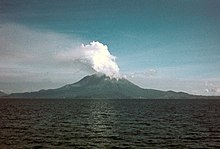

The climate of Japan is predominantly temperate, but varies greatly from north to south. Japan's geographical features divide it into six principal climatic zones:
- Hokkaidō: The northernmost zone has a temperate climate with long, cold winters and cool summers. Precipitation is not heavy, but the islands usually develop deep snow banks in the winter.

- Sea of Japan: On Honshū's west coast, the northwest wind in the wintertime brings heavy snowfall. In the summer, the region is cooler than the Pacific area, though it sometimes experiences extremely hot temperatures, because of the foehn wind phenomenon.
- Central Highland: A typical inland climate, with large temperature differences between summer and winter, and between day and night. Precipitation is light.
- Seto Inland Sea: The mountains of the Chūgoku and Shikoku regions shelter the region from the seasonal winds, bringing mild weather throughout the year.
- Pacific Ocean: The east coast experiences cold winters with little snowfall and hot, humid summers because of the southeast seasonal wind.
- Ryukyu Islands: The Ryukyu Islands have a subtropical climate, with warm winters and hot summers. Precipitation is very heavy, especially during the rainy season. Typhoons are common.
The highest temperature ever recorded in Japan was 40.9 °C (105.6 °F).
The main rainy season begins in early May in Okinawa, and the stationary rain front responsible for this gradually works its way north until it dissipates in northern Japan before reaching Hokkaidō in late July. In most of Honshū, the rainy season begins before the middle of June and lasts about six weeks. In late summer and early autumn, typhoons often bring heavy rain.
Ecology
[edit | edit source]Japan has nine forest ecoregions which reflect the climate and geography of the islands. They range from subtropical moist broadleaf forests in the Ryūkyū and Bonin islands, to temperate broadleaf and mixed forests in the mild climate regions of the main islands, to temperate coniferous forests in the cold, winter portions of the northern islands.
Environment
[edit | edit source]Today, Japan is one of the world's leaders in the development of new environment-friendly technologies. Honda and Toyota hybrid electric vehicles were named to have the highest fuel economy and lowest emissions. This is due to the advanced technology in hybrid systems, biofuels, use of lighter weight material and newer engineering.
As a signatory of the Kyoto Protocol, and host of the 1997 conference which created it, Japan is under treaty obligations to reduce its carbon dioxide emissions and to take other steps related to curbing climate change. The Cool Biz campaign introduced under former Prime Minister Junichiro Koizumi was targeted at reducing energy use through the reduction of air conditioning use in government offices. Japan is preparing to force industry to make big cuts in greenhouse gases, taking the lead in a country struggling to meet its Kyoto Protocol obligations.
Japan is ranked 20th best in the world in the 2010 Environmental Performance Index.
Economy
[edit | edit source]
Japan had the third largest economy in the world, after the United States, at around US $4.7 trillion in terms of nominal GDP and third after the United States and China in terms of purchasing power parity, before China overtook it in 2010. In 2009 Japan's public debt was 193% of its annual gross domestic product. Banking, insurance, real estate, retailing, transportation, telecommunications and construction are all major industries. Japan has a large industrial capacity and is home to some of the largest, leading and most technologically advanced producers of motor vehicles, electronic equipment, machine tools, steel and nonferrous metals, ships, chemicals, textiles and processed foods. The service sector accounts for three quarters of the gross domestic product.
The Big Mac Index shows that Japanese workers get the highest salary per hour in the world. Some of the largest enterprises in Japan include Toyota, Nintendo, NTT DoCoMo, Canon, Honda, Takeda Pharmaceutical, Sony, Panasonic, Toshiba, Sharp, Nippon Steel, Nippon Oil, Japan Tobacco, Tepco, Mitsubishi, 711, Hitachi, Nissan, Æon, Toyota Tsusho, Fujitsu, and Nippon Telegraph and Telephone. It is home to some of the world's largest banks, and the Tokyo Stock Exchange (known for its Nikkei 225 and Topix indices) stands as the second largest in the world by market capitalization. Japan is home to 326 companies from the Forbes Global 2000 or 16.3% (as of 2006).
Japan ranks 12th of 178 countries in the Ease of Doing Business Index 2008 and it has one of the smallest governments in the developed world. Japanese variant of capitalism has many distinct features. Keiretsu enterprises are influential. Lifetime employment and seniority-based career advancement are relatively common in the Japanese work environment. Japanese companies are known for management methods such as "The Toyota Way". Shareholder activism is rare. Recently, Japan has moved away from some of these norms. In the Index of Economic Freedom, Japan is the 5th most laissez-faire of 30 Asian countries.
Japan's exports amounted to 4,210 U.S. dollars per capita in 2005. Japan's main export markets are China 18.88%, the United States 16.42%, South Korea 8.13%, Taiwan 6.27% and Hong Kong 5.49% (for 2009). Japan's main exports are transportation equipment, motor vehicles, electronics, electrical machinery and chemicals. Japan's main import markets are China 22.2%, the U.S. 10.96%, Australia 6.29%, Saudi Arabia 5.29%, UAE 4.12%, South Korea 3.98% and Indonesia 3.95% (for 2009). Japan's main imports are machinery and equipment, fossil fuels, foodstuffs (in particular beef), chemicals, textiles and raw materials for its industries. By market share measures, domestic markets are the least open of any OECD country. Junichiro Koizumi administration commenced some pro-competition reforms and foreign investment in Japan has soared recently.
Japan's business culture has many indigenous concepts such as the nemawashi, the nenko system, the salaryman, and the office lady. Japan's housing market is characterized by limited land supply in urban areas. This is particularly true for Tokyo, the world's largest urban agglomeration. More than half of Japanese live in suburbs or more rural areas, where detached houses are the dominant housing type. Agricultural businesses in Japan often utilize a system of terrace farming and crop yields are high. 13% of Japan's land is cultivated. Japan accounts for nearly 15% of the global fish catch, second only to China. Japan's agricultural sector is protected at high cost.
Science and technology
[edit | edit source]Japan is one of the leading nations in the fields of scientific research, particularly technology, machinery and biomedical research. Nearly 700,000 researchers share a US$130 billion research and development budget, the third largest in the world. Japan is a world leader in fundamental scientific research, having produced fifteen Nobel laureates in either physics, chemistry or medicine, three Fields medalists and one Gauss Prize laureate.
Some of Japan's more prominent technological contributions are found in the fields of electronics, automobiles, machinery, earthquake engineering, industrial robotics, optics, chemicals, semiconductors and metals. Japan leads the world in robotics production and use, possessing more than half (402,200 of 742,500) of the world's industrial robots used for manufacturing. It also produced QRIO, ASIMO and AIBO. Japan is the world's largest producer of automobiles and home to four of the world's fifteen largest automobile manufacturers and seven of the world's twenty largest semiconductor sales leaders as of today.

The Japan Aerospace Exploration Agency (JAXA) is Japan's space agency that conducts space and planetary research, aviation research, and development of rockets and satellites. It is a participant in the International Space Station and the Japanese Experiment Module (Kibo) was added to the International Space Station during Space Shuttle assembly flights in 2008. It has plans in space exploration, such as launching a space probe to Venus, Akatsuki, in 2010, developing the Mercury Magnetospheric Orbiter to be launched in 2013, and building a moonbase by 2030.
On September 14, 2007, it launched lunar orbit explorer "SELENE" (Selenological and Engineering Explorer) on an H-IIA (Model H2A2022) carrier rocket from Tanegashima Space Center. SELENE is also known as Kaguya, the lunar princess of the ancient folktale The Tale of the Bamboo Cutter. Kaguya is the largest lunar probe mission since the Apollo program. Its mission is to gather data on the moon's origin and evolution. It entered into a lunar orbit on October 4, flying in a lunar orbit at an altitude of about 100 km (62 mi).
Infrastructure
[edit | edit source]
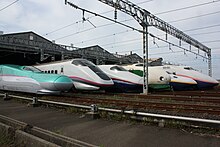

As of 2005, one half of energy in Japan is produced from petroleum, a fifth from coal, and 14% from natural gas. Nuclear power produces a quarter of Japan's electricity.
Japan's traffic is on the left-hand side of the road. A single network of high-speed, divided, limited-access toll roads connects major cities and are operated by toll-collecting enterprises. New and used cars are inexpensive. Car ownership fees and fuel levies are used to promote energy-efficiency. However, at just 50% of all distance travelled, car usage is the lowest of all the G8 countries.
Dozens of Japanese railway companies compete in regional and local passenger transportation markets; for instance, 7 JR enterprises, Kintetsu Corporation, Seibu Railway and Keio Corporation. Often, strategies of these enterprises contain real estate or department stores next to stations. Some 250 high-speed Shinkansen trains connect major cities. Japanese trains are known for their punctuality.
There are 173 airports and flying is a popular way to travel between cities. The largest domestic airport, Haneda Airport, is Asia's second busiest airport. The largest international gateways are Narita International Airport (Tokyo area), Kansai International Airport (Osaka/Kobe/Kyoto area) and Chūbu Centrair International Airport (Nagoya area). The largest ports include Nagoya Port.
Demographics
[edit | edit source]
Japan's population is estimated at around 127.3 million(2013). Japanese society is linguistically and culturally homogeneous with small populations of foreign workers. Zainichi Koreans, Zainichi Chinese, Filipinos, Japanese Brazilians, Japanese Peruvians are amongst the small minorities resident in Japan. In 2003, there were about 136,000 Western expatriates in Japan. The most dominant native ethnic group is the Yamato people; the primary minority groups include the indigenous Ainu and Ryukyuan, as well as social minority groups like the burakumin.
Japan has one of the highest life expectancy rates in the world, at 83.10 years of age as of 2012. The Japanese population is rapidly aging, the effect of a post-war baby boom followed by a decrease in births in the latter part of the twentieth century. In 2004, about 19.5% of the population was over the age of 65.

The changes in the demographic structure have created a number of social issues, particularly a potential decline in the workforce population and increases in the cost of social security benefits such as the public pension plan. Many Japanese youth are increasingly preferring not to marry or have families as adults. Japan's population is expected to drop to 100 million by 2050 and to 64 million by 2100. Demographers and government planners are currently in a heated debate over how to cope with this problem. Immigration and birth incentives are sometimes suggested as a solution to provide younger workers to support the nation's aging population. According to the UNHCR, in 2007 Japan accepted just 41 refugees for resettlement, while the United States took in 50,000.
Japan suffers from a high suicide rate. In 2009, the number of suicides exceeded 30,000 for the twelfth straight year. Suicide is the leading cause of death for people under 30.
Religion
[edit | edit source]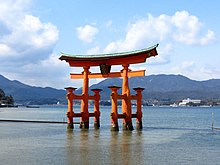
The highest estimates for the number of Buddhists and Shintoists in Japan is 84–96%, representing a large number of believers in a syncretism of both religions. However, these estimates are based on people with an association with a temple, rather than the number of people truly following the religion. Professor Robert Kisala (Nanzan University) suggests that only 30 percent of the population identify themselves as belonging to a religion.
Taoism, Confucianism and Buddhism from China have also influenced Japanese beliefs and customs. Religion in Japan tends to be syncretic in nature, and this results in a variety of practices, such as parents and children celebrating Shinto rituals, students praying before exams, couples holding a wedding at a Christian church and funerals being held at Buddhist temples. Less than one percent in Japan profess Christianity] and possibly less than a half of one percent. The CIA World Fact Book claims two percent (2.4 million).
In addition, since the mid-19th century, numerous religious sects (Shinshūkyō) have emerged in Japan, some of the largest are Seicho-no-Ie at 3 million, Tenrikyo at 2 million, Pl Kyodan at 1 million, Sekai Kyuseikyo at 1 million, Sukyo Mahikari at 1 million, Honmichi at 0.9 million, Konkokyo at 0.5 million, Tensho Kotai Jingukyo at 0.4 million, Ennokyo at 0.3 million(as of 1978), Kurozumikyo at 0.25 million, and Omoto at 0.15 million
Languages
[edit | edit source]More than 99% of the population speaks Japanese as their first language. It is an agglutinative language distinguished by a system of honorifics reflecting the hierarchical nature of Japanese society, with verb forms and particular vocabulary which indicate the relative status of speaker and listener. According to a Japanese dictionary Shinsen-kokugojiten, Chinese-based words make up 49.1% of the total vocabulary, indigenous words are 33.8% and other loanwords are 8.8%.
The writing system uses kanji (Chinese characters) and two sets of kana (syllabaries based on simplified Chinese characters), as well as the Latin alphabet and Arabic numerals. The Ryukyuan languages, also part of the Japonic language family to which Japanese belongs, are spoken in Okinawa, but few children learn these languages. The Ainu language is moribund, with only a few elderly native speakers remaining in Hokkaidō. Most public and private schools require students to take courses in both Japanese and English.
Education and health
[edit | edit source]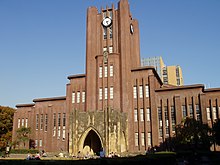
Primary, secondary schools and universities were introduced into Japan in 1872 as a result of the Meiji Restoration. Since 1947, compulsory education in Japan consists of elementary school and middle school, which lasts for nine years (from age 6 to age 15). Almost all children continue their education at a three-year senior high school, and, according to the MEXT, about 75.9% of high school graduates attend a university, junior college, trade school, or other post-secondary institution in 2005.
Japan's education is very competitive, especially for entrance to institutions of higher education. The two top-ranking universities in Japan are the University of Tokyo and Kyoto University. The Programme for International Student Assessment coordinated by the OECD, currently ranks Japanese knowledge and skills of 15-year-olds as the 6th best in the world.
In Japan, healthcare services are provided by national and local governments. Payment for personal medical services is offered through a universal health care insurance system that provides relative equality of access, with fees set by a government committee. People without insurance through employers can participate in a national health insurance program administered by local governments. Since 1973, all elderly persons have been covered by government-sponsored insurance. Patients are free to select physicians or facilities of their choice.
Culture and recreation
[edit | edit source]
Japanese culture has evolved greatly over the years, from the country's original Jōmon culture to its contemporary culture, which combines influences from Asia, Europe and North America. Traditional Japanese arts include crafts (ikebana, origami, ukiyo-e, dolls, lacquerware, pottery), performances (bunraku, dance, kabuki, noh, rakugo), traditions (games, tea ceremony, Budō, architecture, gardens, swords) and cuisine. The fusion of traditional woodblock printing and Western art led to the creation of manga, a typically Japanese comic book format that is now popular within and outside Japan. Manga-influenced animation for television and film is called anime. Japanese-made video game consoles have prospered since the 1980s and continue to have influence around the world.

Japanese music is eclectic, having borrowed instruments, scales and styles from neighboring cultures. Many instruments, such as the koto, were introduced in the ninth and tenth centuries. The accompanied recitative of the Noh drama dates from the fourteenth century and the popular folk music, with the guitar-like shamisen, from the sixteenth. Western classical music, introduced in the late nineteenth century, now forms an integral part of the culture. Post-war Japan has been heavily influenced by American and European modern music, which has led to the evolution of popular band music called J-pop.
Karaoke is one of the most widely practiced cultural activities. A November 1993 survey by the Cultural Affairs Agency found that more Japanese had sung karaoke that year than had participated in traditional cultural pursuits such as flower arranging or tea ceremonies.
The earliest works of Japanese literature include two history books the Kojiki and the Nihon Shoki and the eighth century poetry book Man'yōshū, all written in Chinese characters. In the early days of the Heian period, the system of transcription known as kana (Hiragana and Katakana) was created as phonograms. The Tale of the Bamboo Cutter is considered the oldest Japanese narrative. An account of Heian court life is given by The Pillow Book written by Sei Shōnagon, while The Tale of Genji by Lady Murasaki is often described as the world's first novel.
During the Edo period, literature became not so much the field of the samurai aristocracy as that of the chōnin, the ordinary people. Yomihon, for example, became popular and reveals this profound change in the readership and authorship. The Meiji era saw the decline of traditional literary forms, during which Japanese literature integrated Western influences. Natsume Sōseki and Mori Ōgai were the first "modern" novelists of Japan, followed by Ryūnosuke Akutagawa, Jun'ichirō Tanizaki, Yasunari Kawabata, Yukio Mishima and, more recently, Haruki Murakami. Japan has two Nobel Prize-winning authors—Yasunari Kawabata (1968) and Kenzaburo Oe (1994).
Sports
[edit | edit source]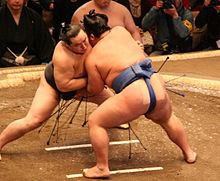
Traditionally, sumo is considered Japan's national sport and it is a popular spectator sport. Martial arts such as judo, karate and modern kendō are also widely practiced and enjoyed by spectators in the country. After the Meiji Restoration, many Western sports were introduced in Japan and began to spread through the education system.
The professional baseball league in Japan was established in 1936. Today baseball is the most popular spectator sport in the country. One of the most famous Japanese baseball players is Ichiro Suzuki, who, having won Japan's Most Valuable Player award in 1994, 1995, and 1996, now plays for the New York Yankees of North American Major League Baseball. Prior to that, Sadaharu Oh was well-known outside Japan, having hit more home runs during his career in Japan than his contemporary, Hank Aaron, did in the United States.
Since the establishment of the Japan Professional Football League in 1992, association football (soccer) has also gained a substantial following. Japan was a venue of the Intercontinental Cup from 1981 to 2004 and co-hosted the 2002 FIFA World Cup with South Korea. Japan is one of the most successful soccer teams in Asia, winning the Asian Cup four times, most recently in 2011.
Golf is also popular in Japan, as are forms of auto racing, such as the Super GT sports car series and Formula Nippon formula racing. Twin Ring Motegi was completed in 1997 by Honda in order to bring IndyCar racing to Japan.
Japan hosted the Summer Olympics in Tokyo in 1964. Japan has hosted the Winter Olympics twice: Sapporo in 1972 and Nagano in 1998. Japan is scheduled to host the Summer Olympics again in Tokyo in 2020.
